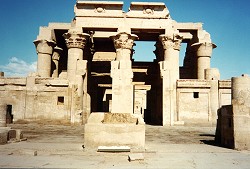
Kom Ombo (Nb(j)t) liegt auf einer Klippe an einer Nilbiegung an der Nordseite einer fruchtbaren Region. Es ist an der Grenze zwischen der arabischen und der nubischen Sprachzone gelegen und ein wichtiger Rastplatz auf Wüstenstrecken. Beinahe alle Denkmäler stammen aus der Ptolemäerzeit, als dieses Gebiet dank verbesserter landwirtschaftlicher Technologien an Bedeutung gewann. Es hatte jedoch auch schon früher Bauaktivitäten gegeben; so hat man beispielsweise zwei Blöcke aus dem Mittleren Reich gefunden, und Champollion entdeckte in der südlichen Umfassungsmauer ein Tor aus der 18. Dynastie. Der früheste erwähnte König ist Ptolemaios VI. Philometor, der Großteil der Dekoration wurde unter Ptolemaios XII. Auletes fertiggestellt. Der Vorhof wurde in der frühen Römischen Zeit dekoriert und ein Eingang hinzugefügt.
Das auffallendste Charakteristikum dieses Tempels ist seine Doppelstruktur - er besitzt doppelte Tore und eine Doppelachse, die zu einem Doppelsanktuar im Inneren führt. Der Tempel ist zwei Triaden geweiht, der aus Sobek, Hathor und Chons sowie der aus Haroeris (Horus dem Älteren), Tasenetnofret (die gute Schwester) und Panebtaui (der Herr der Beiden Länder). Die beiden letzten Namen bezeichnen eher Funktionen als Identitäten, d.h., die des weiblichen und kindlichen Elementes einer Triade. Zusätzlich zum täglichen (doppelten) Kult gab es Prozessionen vom Tempel zur Nekropole, in der die 'toten Götter' begraben waren - Re, Geb und Osiris, die alle drei als Formen des Sobek galten. Die Tempelreliefs lassen erkennen, daß der Tempel in bezug auf das Verhältnis der verschiedenen Gottheiten zueinander eine sehr komplexe Theologie besaß. Dicht am Flußufer befindet sich ein Geburtshaus oder Mammisi, dessen Reliefs unter anderem das Ritual des 'Papyrusraufens' darstellen. Die Verbindung zwischen dem 'Raum der Überschwemmung' und der 'ahet weret', wo die göttliche Hochzeit zwischen Schu und Tefnut stattfand, ist ebenfalls bemerkenswert.